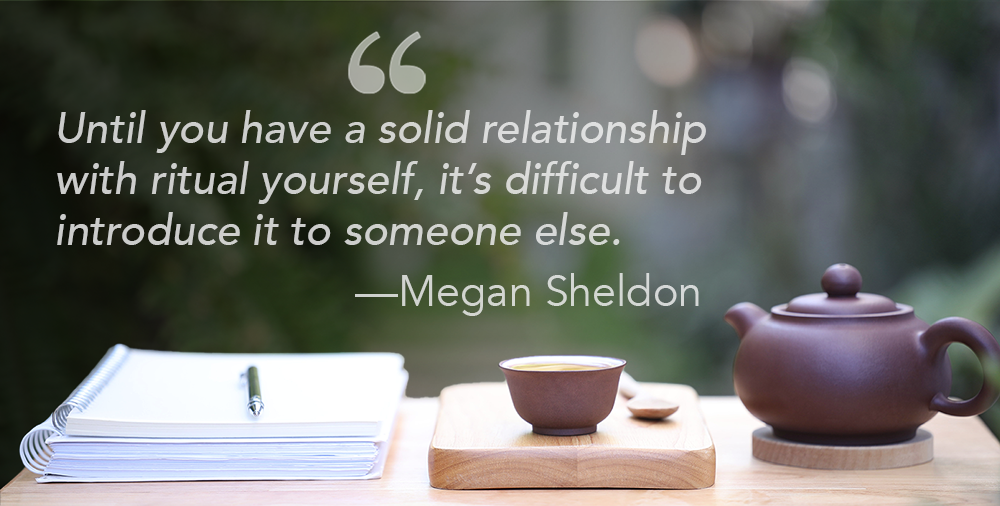Home > WHY WE NEED CEREMONY: INVITING RITUAL IN
WHY WE NEED CEREMONY: INVITING RITUAL IN
by Megan Sheldon
A dear friend, Quanita Roberson, once told me that there’s a ceremony-shaped hole in our society right now. As soon as she said it, I realized that’s what I’ve been feeling my whole life.
I’ve always been drawn to ritual and ceremony. Yet because I’m not religious, nor do I hold strong cultural traditions, I never knew how to bring ritual into my secular life in a way that felt personal and meaningful. I was also cognizant of not wanting to appropriate from other cultures, and I didn’t want to get it wrong.

What Is a Ritual?
For me, a ritual is an intentional action taken with the hope of creating meaning. A ritual can stand alone or it can be a component of a ceremony, like a piece of a puzzle. Rituals don’t need to be complicated or complex; in fact, some of the most powerful rituals are connected to everyday tasks, such as making your morning coffee and using it to set the tone for your day.
The difference between a routine and a ritual is that you fall into a routine, and you step into a ritual. The intention to create meaning is what elevates our everyday actions into the realm of ritual.
What Is Ceremony?
I interpret ceremony as a series of rituals, each one strung together to create a larger story. A ceremony offers people an opportunity to release the past, be still in the present, and set intentions for the future. Ceremonies help us move through times of change and transition with attention and intention.
I believe that rituals and ceremonies can be shaped and reshaped into what we need, when we need them. The world keeps changing, and our rituals should reflect that change and adapt as needed.
My Journey to Ritual
For many years, I felt stuck and unsure of how to have a relationship with ritual and ceremony, until I realized I was drowning in grief without them. Ten years ago, my husband and I experienced three recurrent miscarriages while losing his father to ALS, amyotrophic lateral sclerosis. It was then that I knew just how important ritual and ceremony were in helping people acknowledge both the visible and invisible losses we experience every day.
I started to create rituals for myself, for our family, and for my community. With a degree in cultural mythology, I looked to the history of ritual and ceremony in different cultures. I leaned on my training with The Art of Hosting and Circle Way, which helped me see a ceremony as a conversation that can connect us to ourselves, each other, and the world around us.
I became a Life-Cycle Celebrant and an end-of-life doula, taking my training with INELDA educator Nicole Heidbreder, who helped me see the connections between birth, death, and all of the moments in between. I started to create ceremonies for other people, with a focus on end of life. Together, we crafted ceremonies surrounding the seemingly invisible moments when we don’t always know what to do. Moments such as receiving a terminal diagnosis or planning a living funeral, creating a unique celebration of life or honoring a death anniversary.
Since starting this journey, I’ve designed hundreds of ceremonies for people around the world, helping them mark beginnings and endings—in relationships, in careers, in birth, and in death. I believe that ritual and ceremony can help us process difficult experiences, share our stories, and connect us at a deeper level.
I also know that becoming ceremonial is like building a muscle—the more you invite rituals into your daily life, the stronger those ritual muscles become so that when something turbulent happens in your life, you already have a ritual practice in place. When we created Be Ceremonial, it was with the notion to give people a place to start.
So Where Can You Start?
A ceremony is often structured like a rite of passage, with three distinct stages: separation, transition, and incorporation. When you plan a ceremony, we invite you to consider all the different ways you can move through those three stages. You can create a ritual to help you separate from what was or release the past. You can create a ritual to help you be present in the moment and transition toward the future. And finally, you can create a ritual to incorporate what you’ve learned and set intentions for what will be.
My advice for anyone wanting to support someone with a ceremony is to start simple —find something small and meaningful and symbolic that you can elevate into the realm of ritual. Until you have a solid relationship with ritual yourself, it’s difficult to introduce it to someone else.
We all connect with ritual and ceremony in different ways. For some, rituals are simply actions that fold into the day, like intentionally getting out of bed the same way each morning. For others, rituals are grand gestures that bring people together, like a wedding or annual holiday event. Our relationship with ritual is continually evolving, so finding your own way to describe your relationship with ritual is essential if you want to start creating ceremonies for others.
There are so many ways you can invite ritual and ceremony into the end-of-life realm, both for yourself and for others. Once you start becoming more ceremonial, you’ll see that ceremony is everywhere and that there are endless possibilities when it comes to reimagining the role of ritual in our lives.
